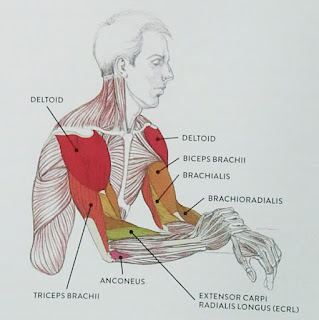Classic Human Anatomy in Motion
by Valerie L. Winslow ISBN-13: 9780770434144 Hardcover: 304 pages Publisher: Watson-Guptill Released: August 4, 2015 |
Source: Review copy from the publisher through Blogging for Books.
Book Description from Cover:
Fine-art instruction books do not usually focus on anatomy as it relates to movement, despite its great artistic significance. Written by a long-time expert on drawing and painting human anatomy, Classic Human Anatomy in Motion offers artists everything they need to realistically draw the human figure as it is affected by movement.
Written in a friendly style, the book is illustrated with hundreds of life drawing studies (both quick poses and long studies), along with charts and diagrams showing the various anatomical and structural components.
This comprehensive manual features five distinct sections, each focusing on a different aspect of the human figure: bones and joint movement, muscle groups, surface form and soft tissue characteristics, structure, and movement. Each chapter builds an artistic understanding of how motion transforms the human figure and can create a sense of expressive vibrancy in one's art.
My Review:
Classic Human Anatomy in Motion is an anatomy book for artists who draw, paint, or sculpt human nudes. Much of the information can be applied to clothed figures, too. The nude figures were posed respectfully rather than shown in sexually suggestive poses.
This book contained high-quality illustrations. There were illustrations showing the bones and muscles of the human body like you'd find in an anatomy book, and the author described the motions that each joint can do and how muscles work. This helps you to realistically render the human body when it's in motion. The author pointed out which features can be seen on the surface and to look for them as reference points when drawing.
The author described how to draw a figure from models, everyday life, pictures, or video. She suggested warm-up exercises and ways to suggest an active (rather than passive) figure. She gave advice about working from your imagination, but she assumed that you'll usually have some reference to draw from as you work. Overall, I'd recommend this book to artists who want to improve their depictions of human figures.
If this review looks familiar, that's because I previously reviewed the NetGalley ebook version of this book. When I requested this book through Blogging for Books, 7 months and about 140 books had passed by. I assumed it was a new book by this author, and I was so excited to have a chance at a hardback version. The hardback version is an oversized book, so it's easier to work from than the ebook I was viewing on my computer screen.
If you've read this book, what do you think about it? I'd be honored if you wrote your own opinion of the book in the comments.
Excerpt: My photos of the book don't do it justice, but they show some of the things taught in the book.








No comments:
Post a Comment